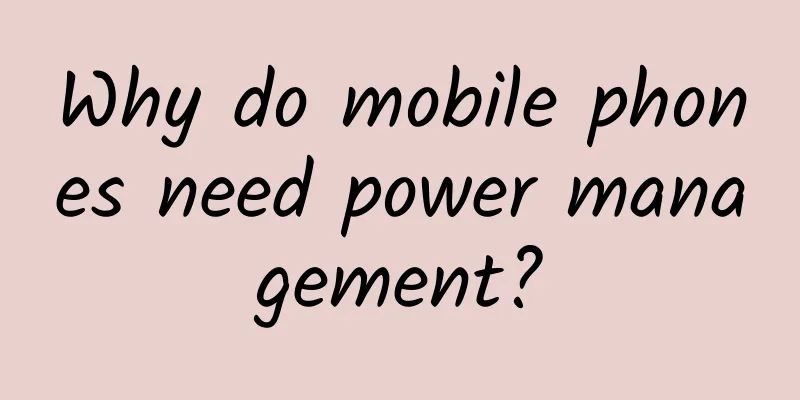Why do mobile phones need power management?

|
Why do mobile phones need power management? Because most mobile phones are powered by single-cell lithium batteries (in the battery circle, all batteries with a nominal voltage of about 3.6V are called single-cell batteries. Although they may be two batteries connected together, they are actually equivalent to a battery cut in half, which automatically balances the current and makes no difference to the circuit). When the battery is fully charged, the open circuit voltage is about 4.2-4.3V, and when the battery is exhausted, it is about 2.5-3.0V. Simple electrical appliances, such as remote controls, may be able to design circuits that can work in such a wide voltage range. But mobile phones are not like this. Mobile phones are very complex. For various technical and historical reasons, each part requires different power supplies, sometimes boosting, sometimes reducing, and sometimes controlling current. Power supply requirements of various parts of mobile phones 1. Application processor The first major power consumer is the "application processor". The application processor is generally made with the most advanced technology. It generally requires at least two voltages, one of which is the core voltage, which can generally be less than 1V, in order to make the application processor fast and low power. Although the voltage is low, it has transistors counted in "billions", so the current consumed is considerable. Another voltage is the I/O voltage, usually 1.8v or 3.3V, which has been a standard voltage for a long time, in order to communicate with other small chips on the chip. So in addition to improving the process and reducing the core voltage, what other ways are there to reduce power consumption? The processor has two power consumptions. The first is switching loss. Every time the gate circuit is switched, a certain amount of energy will be lost. Therefore, changing the operating clock frequency according to needs is the most important energy-saving method. (The voltage should also be adjusted with the frequency) Even if the clock is completely cut off, the processor still has some leakage loss, and due to the progress of semiconductor manufacturing, this loss has a tendency to increase. The processor generally has multiple power domains. The solution is to turn off the power of the temporarily unused part. This has the effect of pulling the power off. It's just that it will take a little time for you to turn on this part next time. There is also the problem of processor architecture. Generally speaking, simple sequential execution processors are more power-saving than out-of-order complex processors. So a dedicated standby core is a very smart approach. 2. Screen and backlight The second power consumer is the screen. For LCD screens, it is generally necessary to connect many LED lamp beads in series to form a backlight, and a boost circuit is required. The screen backlight is at the watt level. This is also related to the aperture ratio and light transmittance of the LCD panel. When the screen is to be brightened, the energy consumption is growing disproportionately. Therefore, reducing the screen brightness is always a good way to save power. For OLED screens, since the black part does not emit light and consumes power, designing the UI to be black will help save a lot of power. 3. RF module The radio module is sometimes also a big power consumer. When the signal conditions are good, the RF power amplifier only transmits at a power of 10mW. When the signal conditions are poor, the transmission power will be increased to a maximum of 2W. The RF power amplifier of a mobile phone varies by a hundred times under different signal conditions. It is not difficult to understand why the standby time of a mobile phone is short when the signal is poor. But if the mobile phone is in a place without a signal, such as a tunnel, the mobile phone will try to contact the base station with the maximum transmission power. If it cannot be contacted, it will reduce the search frequency to save power. As a winner of Toutiao's Qingyun Plan and Baijiahao's Bai+ Plan, the 2019 Baidu Digital Author of the Year, the Baijiahao's Most Popular Author in the Technology Field, the 2019 Sogou Technology and Culture Author, and the 2021 Baijiahao Quarterly Influential Creator, he has won many awards, including the 2013 Sohu Best Industry Media Person, the 2015 China New Media Entrepreneurship Competition Beijing Third Place, the 2015 Guangmang Experience Award, the 2015 China New Media Entrepreneurship Competition Finals Third Place, and the 2018 Baidu Dynamic Annual Powerful Celebrity. |
<<: Summary of the first day of ChinaJoy: Consoles are here, mobile games have changed
Recommend
A complete marketing planning template!
The complete market plan is mainly divided into t...
Tianshu · Zhihu Carrying Goods Episode 3, Teach You How to Quickly Get Started with Zhihu Good Goods Selection, Content and Operation (Attached 2 Episodes)
Tianshu · Zhihu Carrying Goods Episode 3, Teach Y...
Do you really know what these aerospace terms mean?
Payload, window... Do you really know what these ...
What efforts have scientists made to prevent your poop from sticking to the toilet?
Produced by: Science Popularization China Author:...
August 2021 "Science" Rumors List: Camel milk is closer to breast milk? Are electric cars not afraid of being soaked in water?
The August "scientific" rumor list is r...
Talk about the pre-installed software on mobile phones
[[139053]] CCTV has started to crack down on pre-...
WeChat rewards everyone with a top-of-the-line iPhone. Zhang Xiaolong: The year-end bonus is so high that it might scare everyone.
Although the overall situation in 2018 is not goo...
ToB operations, 7 pitfalls to avoid
If you stand in the right place, even a pig can f...
To do a good job of through train promotion, we need to simplify the cumbersome
Almost all real sellers have used Through Train. ...
Chow Yun-fat's complete film collection, Chow Yun-fat's complete film collection in Mandarin version free Mandarin version Baidu Cloud
All Chow Yun-fat's movies: Chow Yun Fat was b...
An introduction to the promotional material specifications for Tiantian Ptu splash screen advertising!
1. Daily P-picture splash ads Displayed to users ...
7 cases of myocardial infarction were treated in one and a half days! Doctor: They all have these common characteristics!
Reviewer of this article: Chen Haixu, Deputy Dire...
Why have you read so much useful information but still haven’t improved?
Many of the students I have met who are engaged i...
Starting at RMB 129,800, Aion Tyrannosaurus Rex aims to be a new global classic
On July 23, Aion's first global strategic mod...
Apple’s color philosophy: Is gold really made for Asia?
Apple first launched the gold iPhone 5s, then the...









